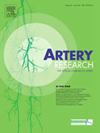介入治疗与保守治疗对下肢动脉硬化闭塞症的疗效及预后危险因素分析
IF 1.6
4区 医学
Q4 PERIPHERAL VASCULAR DISEASE
引用次数: 1
摘要
背景:动脉硬化闭塞症(ASO)是导致下肢截肢的重要原因。我们的目的是比较介入治疗和保守治疗对下肢ASO的影响,并分析影响预后的危险因素。方法:98例患者随机分为实验组(n = 50)和对照组(n = 48)。对照组给予保守治疗,实验组给予保守治疗和介入治疗。记录患者的基线临床资料、住院时间、跛行距离、卢瑟福期、病变动脉、踝肱指数(ABI)、临床结局和不良事件。然后将患者分为预后不良组(n = 31)和预后良好组(n = 67),通过单因素和多因素分析探讨危险因素。结果:实验组住院时间明显短于对照组(p < 0.05)。治疗后,实验组患者卢瑟福期缩短,血管通畅率和总有效率升高(p < 0.05)。两组患者的跛行距离、ABI均较治疗前显著升高,其中试验组差异尤显著(p < 0.05)。实验组大鼠心脑血管事件、截肢、死亡发生率显著低于对照组(p < 0.05)。年龄、保守治疗、吸烟、高血压、糖尿病、高脂血症、纤维蛋白原是预后不良的独立危险因素(p < 0.05)。年龄0 ~ 70岁及纤维蛋白原水平>4 g/L对预后影响较大。结论:介入治疗下肢ASO疗效好,安全性高,恢复容易,并发症少。高龄、保守治疗、吸烟、本文章由计算机程序翻译,如有差异,请以英文原文为准。
Therapeutic Effects of Interventional Therapy and Conservative Therapy on Lower Extremity Arteriosclerosis Obliterans and Risk Factors for Prognosis
Background: Arteriosclerosis Obliterans (ASO) is an important cause for lower limb amputation. We aimed to compare the effects of interventional and conservative therapies on lower extremity ASO, and to analyze the risk factors for prognosis. Methods: Ninety-eight eligible patients were randomly divided into experimental ( n = 50) and control groups ( n = 48). Conservative therapy was conducted for control group, and experimental group was given conservative and interventional therapies. Their baseline clinical data, hospital stay length, claudication distance, Rutherford stage, diseased arteries, Ankle-Brachial Index (ABI), clinical outcomes and adverse events were recorded. Then they were divided into poor ( n = 31) and good prognosis groups ( n = 67), and risk factors were explored by univariate and multivariate analyses. Results: The hospital stay length of experimental group was significantly shorter than that of control group ( p < 0.05). After treatment, Rutherford stage decreased, and vascular patency rate and total response rate rose in experimental group ( p < 0.05). Claudication distance and ABI significantly increased in both groups compared with those before treatment, especially in experimental group ( p < 0.05). The incidence rates of cardiovascular and cerebrovascular events, amputation and death were significantly lower in experimental group ( p < 0.05). Age, conservative therapy, smoking, hypertension, diabetes mellitus, hyperlipidemia and fibrinogen were independent risk factors for poor prognosis ( p < 0.05). Age of >70 years old and fibrinogen level of >4 g/L had greater effects on prognosis. Conclusion: Interventional therapy works well for lower extremity ASO, with high safety, easy recovery and mild complications. Poor prognosis is caused by old age, conservative therapy, smoking,
求助全文
通过发布文献求助,成功后即可免费获取论文全文。
去求助
来源期刊

Artery Research
Medicine-Cardiology and Cardiovascular Medicine
CiteScore
1.70
自引率
16.70%
发文量
14
审稿时长
13 weeks
期刊介绍:
Artery Research is the official journal of the Association for Research into Arterial Structure and Physiology (ARTERY) which promotes the advancement of knowledge and dissemination of information concerning the pathophysiology, epidemiology, detection, investigation and treatment of arterial structure and function. The journal publishes original research articles, review articles, perspectives, case-studies, letters to the Editor, short communications and images. All submitted material is subject to a strict peer-review process.
 求助内容:
求助内容: 应助结果提醒方式:
应助结果提醒方式:


